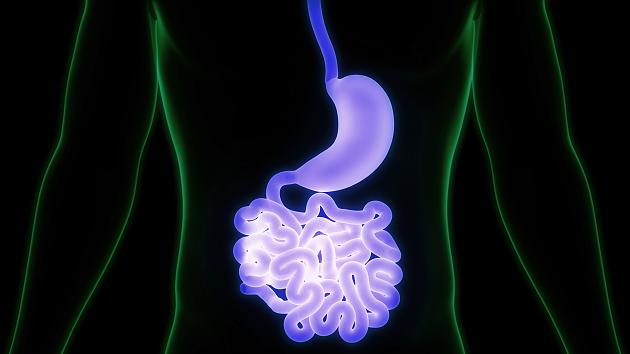When it comes to colon cancer, most people think of colon cancer. What is less well known is that the small intestine can also develop malignant tumors. What you should know about it, about symptoms, treatment and the combination of colon and small bowel cancer.
Small bowel cancer accounts for up to five percent of all bowel cancers; around 2,600 men and women were diagnosed with small bowel cancer in 2016, compared with around 60,000 colon cancer. “It is important to classify a carcinoma on the one hand by localization, i.e. in the case of bowel cancer, small or colon cancer, but also differentiate it on the basis of its biological characteristics,” reports Ulrich Graeven, chief physician at the Clinic for Hematology, Oncology and Gastroenterology at Maria Hilf Mönchengladbach Hospital.
Cancer of the small intestine is usually biologically very different from cancer of the colon
While colon cancer is usually adeno tumors, i.e. growths of the mucous membrane, this affects only a small fraction of small bowel cancer. The most common forms of small bowel cancer, depending on the cells that cause the disease, are:
- Neuroendocrine tumors (NET) with around 50 percent, they arise from hormone-producing cells
- Gastrointestinal stromal tumors (GIST) make up about ten percent, these tumors originate from the connective tissue in the gastrointestinal tract.
The differing biological characteristics of the two types of colon cancer, colon and small bowel cancer, “make these two diseases so fundamentally different, even though both affect the bowel,” explains the oncologist.
Causes of small bowel cancer and why it is less common than colon cancer
What triggers the fact that the cells in the small intestine no longer act normally, but degenerate and multiply in an uncontrolled manner, is still largely unknown. It is assumed that there is a connection with pollutants in food that come into contact with the small intestine during passage and can thus influence its cells.
It is well known that the small intestine connects directly to the stomach. This first section of the three-part small intestine is called the duodenum, followed by the jejunum and ileum. In addition to transporting the chyme to the large intestine, the task of the five-meter-long small intestine is to break down certain food components and release them into the blood. The most important ones are carbohydrates, which are processed into various sugars, fat, but also vitamins and trace elements.
The chyme is still thin in this section of the intestine and is therefore transported on quickly. The contact time with the intestinal wall is much shorter than later in the large intestine, “which could explain why colon cancer is much more common than small intestine cancer,” the gastroenterologist explains the possible background. In addition, the mucous membrane in the small intestine is less susceptible to certain factors such as pollutants than that in the large intestine.
Risk factor hereditary diseases
However, there is also a familial willingness to develop small bowel cancer: Hereditary polyposis syndromes such as familial adenomatous polyposis (FAP) and Lynch syndrome. Genetically, a large number of polyps develop in the large intestine, sometimes also in the small intestine. These are adenocarcinomas, but are very rare in the small intestine compared to NET and GIST.
Small intestinal tumors associated with FAP are usually only discovered when polyps have been detected in the large intestine. In the course of further diagnosis of the familial predisposition, these rare small bowel carcinomas are also identified.
Small bowel cancer symptoms
Small bowel cancer usually grows slowly. Frequently, signs only appear when the disease has progressed and the tumor is taking up space. Depending on you can
- Bleeding,
- Stomach pain,
- nausea
- Constipation or diarrhea
occur. If the tumor is large, it can even block the intestines (ileus). The intestinal obstruction manifests itself through massive pain, it is always a medical emergency that is life-threatening and must be treated immediately.
Small bowel cancer prognosis varies
Small bowel cancer is usually only discovered at an advanced stage. In more than 70 percent, the carcinoma is only diagnosed in stage three or four, i.e. later than this applies to this common colon cancer – again the comparison with colon cancer.
The survival rates for small bowel cancer are therefore somewhat lower. “The decisive factor, however, is always the type of cancer of the small intestine,” explains the expert. If a GIST or NET is detected early, the chances of survival are very good. If, on the other hand, it is adenocarcinoma, which is also usually discovered later, the prognosis is not quite as favorable.
Diagnosis of small bowel cancer
The classic examination methods of gastroscopy and colonoscopy only cover the upper or lower part of the small intestine, “the almost five meters in between are not reached with these examination techniques,” explains the expert.
Imaging methods such as magnetic resonance tomography (MRT) or computed tomography (CT) are only used if there are symptoms and suspicion of this intestinal tumor. Capsule endoscopy, which shows images from the small intestine, also provides information.
Only when these examinations reveal an abnormality is it possible to specifically mirror the small intestine. “However, this is very time-consuming and cannot be used as a preventive examination – also because these intestinal tumors are very rare,” emphasizes Ulrich Graeven.
Small intestinal cancer therapies – surgery and its consequences
Overall, the following applies to the various small intestinal tumors: If possible, an operation should be performed. “If the tumor is limited, parts of the small intestine can usually be removed without any problems,” explains the oncologist in more detail.
A stoma, i.e. an artificial anus, is therefore usually not necessary. However, it is crucial which part of the small intestine is missing and which functions it had, which trace elements and vitamins it passed on to the body. This deficiency must then be compensated for through appropriate nutrition or medication.
Treatment for small bowel cancer varies depending on the type of tumor
Parts of the removed tumor are examined histologically. For the therapy plan, it is crucial whether it is NET, GIST or the rare familial adenocarcinoma in the small intestine. “A generally applicable therapy scheme for small bowel cancer is not possible because there is not just one small bowel cancer, but different ones, it always depends on its type,” emphasizes the oncologist.
Accordingly, there are many different therapy options. If a gastrointestinal stromal tumor (GIST) has metastasized, for example, there are very good drugs for further treatment. “This is not the classic chemotherapy, but we use so-called tyrosine kinase inhibitors, with very good results,” reports the expert. These are inhibitors, such as imitanib, that can block certain signaling pathways within the cells. They are sometimes also used before an operation to reduce the size of a tumor that is too large and therefore inoperable, or after an operation to avoid a relapse.
If the cancer of the small intestine is a neuroendocrine tumor (NET), on the other hand, surgery is often the only treatment required. The NET is further subdivided with regard to the need for drug therapy, taking into account its growth rate. This subdivision of the NET is also of crucial importance for planning therapy for metastatic NET.
Ademocarcinoma of the small intestine is treated on the basis of the results from the treatment of colon tumors.
Small bowel cancer prevention
Targeted prevention against these rare tumors is hardly possible – apart from the well-known rules for a healthy life, i.e. without smoking, with a sensible diet, extensive alcohol restriction and sufficient exercise. Because little is known about the possible causes of small bowel cancer, they cannot be influenced.
However, there is an important tip from the expert for everyone in whose families there are genetically determined polyps in the large intestine: Remember to not only limit the preventive measures to the large intestine, but also to extend it to the small intestine. Although this is provided for in the relevant colorectal cancer screening and follow-up programs, it must not be overlooked.




